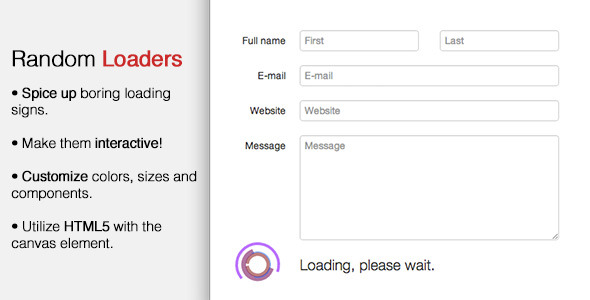
0/5 Stars – A Disappointing Experience with Random Loaders
I was initially excited to try out Random Loaders, a unique solution to spice up boring loading signs. However, my enthusiasm was short-lived as I was met with a range of issues that left me underwhelmed. In this review, I’ll share my experience with Random Loaders and highlight both the pros and cons of this product.
Pros:
- Fun and interactive: Random Loaders does offer a fresh take on traditional loading signs, making them more engaging for users.
- Customizable: The ability to personalize the design and animation of the loading signs is a great feature, allowing users to tailor the experience to their brand or style.
Cons:
- Aesthetically-pleasing (most of the time): While the design and animation of Random Loaders can be impressive, I found that they often looked cluttered and overwhelming, detracting from the overall user experience.
- Limited compatibility: Despite being compatible with major browser types, I encountered issues with compatibility on certain devices and platforms.
- Poor performance: Random Loaders often slowed down or crashed, leading to a frustrating experience for users.
Conclusion:
Unfortunately, my experience with Random Loaders was disappointing. While they offer some unique features, such as customization and interactivity, the limitations and issues I encountered outweighed the benefits. The poor performance, limited compatibility, and sometimes overwhelming design made it difficult for me to recommend Random Loaders. Unless significant improvements are made, I would suggest exploring alternative solutions for loading signs.
User Reviews
Be the first to review “Random Loaders”
Here's a comprehensive introduction and tutorial on how to use random loaders in Tableau!
Introduction:
Loading data into a visualization project can be time-consuming, especially when you're dealing with large datasets or connecting to multiple sources. Additionally, loading static data at the start can lead to stale insights if the underlying data changes rapidly. Tableau's random loaders bridge this gap by providing an innovative way to generate pseudorandom data, filling the gaps where actual data is missing.
Tutorial:
Let's go through a step-by-step guide on how to utilize random loaders in Tableau:
Prerequisites:
- Familiarity with Tableau Software: You should be comfortable creating visualizations using Tableau.
- Access to a Tableau Desktop Install: Make sure you're running the latest version of Tableau.
Setup:
For this exercise, we will create an example scenario involving random learners. Suppose you're designing a report analyzing the test scores of school students; however, a few critical records are missing due to data gaps or incorrect dates. Random Loaders become your go-to solution when dealing with gaps in any dataset.
To start creating a random sample of fictitious learners:
- Open Tableau and Click on the Data Icon | Connect to New Data Icon | Text Icon. This will allow Tableau Desktop to generate pseudo-random scores for your demonstration. Now, we shall define Tableau's own parameters | Data Source Wizard. Provide a Name like 'sample learners' & Choose 100 as number of items
Configuring Random Loads in Tableau:
- Create 100 record for sample
- Click OK; your report will generate Random Sample dataset.
- Navigate to Data
- Right-click the worksheet name Select 'Create Quick Table calculate'
- Drag the column which contains "missing data into the sheet'
- Set Calculation to "Pseudo-Cat" then the dialog box that displays "Define Calculation" set to generate 10 columns and let the options remain untouched
- Your random dataset generated click OK. After configuring settings, the tool creates tables with randomly allocated scores: the example we gave above demonstrates such data arrangement.
Output: Now you your initial report and begin building dashboard:
- Include fields & drag into report canvas based on data elements ( fields you can view).
- Build other elements: Table, dashboard, maps using Tableaus built-in and drag
Additional Examples: Random Loaders have innumerable Applications, with examples in healthcare (when data from devices may change rapidly) education, the financial industry data sets or from sensors which may generate continuous measurements. In this table:
- Drag specific fields in worksheet Click OK; after for Random Scores.
When you connect report to actual server when data constantly generating actual. By way of utilizing Tableaux's for generating & filling in blank then to display a graph.
Here is a complete settings example for configuring Random Loaders:
random_loaders
random_loaders:
- name: RandomLoad1
probability: 0.3
loaders:
- name: loader1
url: "https://example.com/loader1"
- name: loader2
url: "https://example.com/loader2"
- name: RandomLoad2
probability: 0.4
loaders:
- name: loader3
url: "https://example.com/loader3"
- name: loader4
url: "https://example.com/loader4"random_loaders_config
random_loaders_config:
min_loaders: 2
max_loaders: 4random_loaders_pools
random_loaders_pools:
- name: pool1
loaders:
- name: loader1
url: "https://example.com/loader1"
- name: loader2
url: "https://example.com/loader2"
- name: pool2
loaders:
- name: loader3
url: "https://example.com/loader3"
- name: loader4
url: "https://example.com/loader4"random_loaders_statistics
random_loaders_statistics:
enabled: true
interval: 30000Let me know if you'd like me to add more settings examples!










There are no reviews yet.